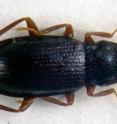New endemic beetles discovered in Iberian Peninsula
A European research team, with Spanish participation, has described two new beetle species measuring two millimetres in length. The coleoptera (beetles) were found in streams in the Pyrenees and Pre-Pyrenees mountains (from Gipuzkoa to Girona) and in the Sierra de la Demanda mountains (Burgos). Experts had previously thought that they belonged to another European species. "These species, which have a restricted range, had been confused with another European species with a more extensive distribution (Hydraena saga) and so their independent evolutionary history was unknown", Ignacio Ribera, one of the authors of the study and a researcher at the Institute of Evolutionary Biology (CSIC-UPF) in Barcelona, tells SINC.
Hydraena diazi, one of the two new beetle species, was found in the Montseny Natural Park in Barcelona. Measuring between 2.2 and 2.4 millimetres in length, the insect also inhabits the Pyrenees and Pre-Pyrenees, from Gipuzkoa to Girona.
The study, which has been published recently in the journal Zootaxa, also confirms the existence of another new species, Hydraena fosterorum, discovered in another mountain chain, the Sierra de la Demanda (Burgos).
Individuals of this species, which are also found in the north of the Sistema Ibérico mountains (Sierra del Moncayo), measure between 2.15 and 2.30 millimetres. According to Ribera, the two species "are exclusive to well-conserved streams", and are similar to the insects in the Pyrenees.
The most characteristic feature of these insects is the males' genital organs and their molecular data, as well as the fact they are endemic to the Iberian Peninsula. "Most probably they originated in the same geographical regions that they are now found in, meaning we can use them to reconstruct their history and biogeography", the expert explains.
An ancestor half a million years ago
In order to classify the species, the researchers used a combination of morphological and genetic studies. The results show that the small genetic variations between the new species and the proximity of their geographic distribution agree with the model put forward by Ribera.
The research also suggests that all the species in the Hydraena emarginata-saga group, including the two new ones, result from the splitting of a common ancestor, which spread throughout the north of the Iberian Peninsula half a million years ago. Today, the insects remain in their original distribution areas.
Source: FECYT - Spanish Foundation for Science and Technology
Other sources
- New endemic beetles discovered in Iberian Peninsulafrom Science Daily13 years ago
- New endemic beetles discovered in Iberian Peninsulafrom Physorg13 years ago


